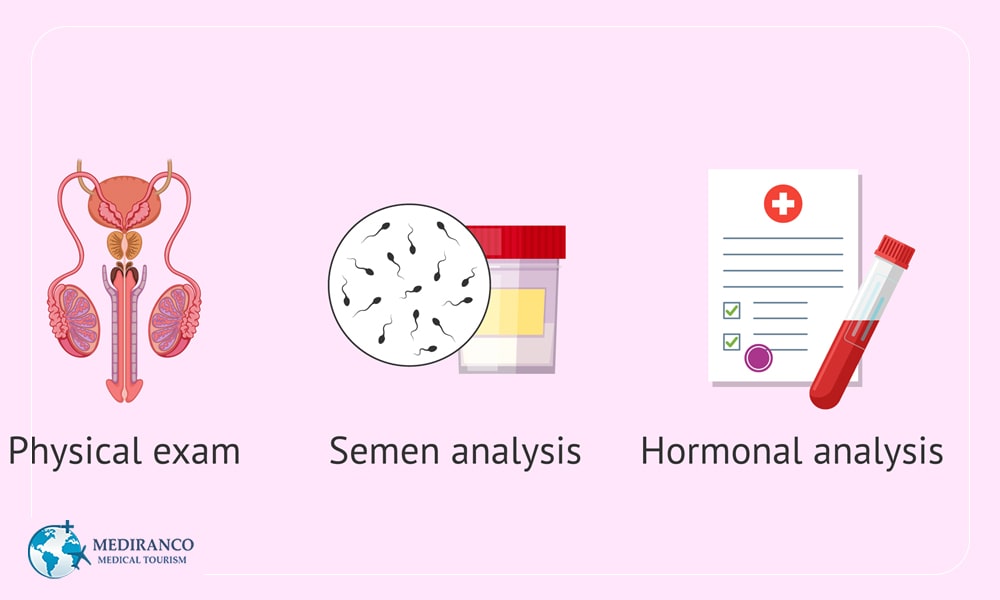Male infertility is a pervasive reproductive health concern that affects countless couples globally. Contrary to common perception, it’s not solely a female issue; male factors contribute to infertility in up to half of all cases. This guide explores the intricate landscape of male infertility, investigating its diverse causes, diagnostic methods, and treatment modalities. From genetic and hormonal factors to lifestyle choices and environmental influences, we’ll uncover the root causes. We’ll delve into essential diagnostic tools like semen analysis and hormonal assessments, and discuss treatment avenues, including lifestyle modifications, medications, surgeries, and assisted reproductive technologies. This guide aims to empower individuals and couples by shedding light on this often-overlooked aspect of fertility.
Male infertility can result from a range of factors, encompassing genetic, hormonal, lifestyle, medical, and environmental elements. Understanding these causes is crucial for diagnosing and addressing male infertility effectively:
Table of Contents
ToggleCauses of Male Infertility
1. Genetic Factors:
- Klinefelter Syndrome: This genetic condition results in men having an extra X chromosome (XXY) instead of the typical XY, leading to reduced sperm production and testicular size.
- Y Chromosome Microdeletions: Missing or deleted segments of the Y chromosome can disrupt sperm development and maturation.
- Cystic Fibrosis Gene Mutations: Some gene mutations associated with cystic fibrosis can also cause congenital bilateral absence of the vas deferens (CBAVD), blocking the passage of sperm.
2. Hormonal Imbalances:
- Low Testosterone Levels: Insufficient testosterone production can impair sperm production.
- Hyperprolactinemia: Elevated levels of the hormone prolactin can disrupt the hypothalamus-pituitary-testes axis, affecting sperm production.
- Hypogonadotropic Hypogonadism: This condition involves low levels of gonadotropin hormones, which are crucial for sperm production.
3. Lifestyle Factors:
- Smoking: Smoking tobacco has been linked to decreased sperm count and motility.
- Alcohol and Drug Use: Excessive alcohol consumption and drug use, including anabolic steroids, can negatively impact sperm quality.
- Obesity: Being overweight or obese can lead to hormonal imbalances and reduced fertility.
4. Medical Conditions:
- Diabetes: Poorly managed diabetes can lead to neuropathy and erectile dysfunction, impacting fertility.
- Sexually Transmitted Infections: Infections like chlamydia and gonorrhea can cause scarring and blockage of the reproductive tract.
- Varicocele: Enlarged veins in the scrotum (varicocele) can raise testicular temperature, affecting sperm production.
5. Environmental Factors:
- Exposure to Toxins: Occupational exposure to pesticides, heavy metals, and other toxins can harm sperm quality.
- Radiation and Heat: Excessive exposure to radiation (e.g., X-rays) and prolonged heat (e.g., hot tubs or saunas) can reduce sperm production.
It’s important to note that sometimes the exact cause of male infertility may not be readily apparent, and multiple factors may contribute simultaneously. A thorough evaluation by a healthcare provider, including a detailed medical history and diagnostic tests, is essential to pinpoint the specific causes in each case. Understanding these causes allows for targeted treatment strategies to improve male fertility and increase the chances of achieving a successful pregnancy.
You can contact Mediranco health tourism company regarding your concerns about Infertility treatments in Iran at any time!
Diagnosis of Male Infertility

Diagnosing male infertility involves a series of evaluations and tests designed to identify the underlying causes of reproductive challenges. A comprehensive diagnostic process is essential to determine the most appropriate treatment options. Here are some key components of the diagnosis of male infertility:
1. Medical History and Physical Examination:
- The initial step involves a detailed medical history to identify potential risk factors, such as previous surgeries, medical conditions, or lifestyle choices.
- A physical examination can help detect abnormalities in the reproductive organs, including the testes, epididymis, and scrotum.
2. Semen Analysis:
- Semen analysis is a fundamental diagnostic tool. It assesses various semen parameters, including sperm count, motility, morphology (shape), and volume.
- Abnormal results may indicate issues with sperm production, function, or transport within the reproductive tract.
3. Hormone Testing for Diagnosis of Male Infertility:
- Blood tests can measure hormone levels critical to male fertility, such as testosterone, follicle-stimulating hormone (FSH), and luteinizing hormone (LH).
- Hormone imbalances can help identify conditions like hypogonadism or hyperprolactinemia that affect sperm production.
4. Genetic Testing:
- Genetic tests can identify chromosomal abnormalities or genetic mutations that may contribute to male infertility.
- Testing may include karyotype analysis, Y chromosome microdeletion analysis, and genetic screening for specific conditions.
5. Imaging Tests for Diagnosis of Male Infertility:
- Ultrasound or other imaging techniques may be used to evaluate the structure of the reproductive organs, including the testes, epididymis, and vas deferens.
- Imaging can detect abnormalities such as varicoceles or blockages in the reproductive tract.
6. Functional Tests:
- Functional tests, such as the post-ejaculation urinalysis, assess whether sperm is entering the bladder during ejaculation, a condition known as retrograde ejaculation.
7. Sperm Antibody Testing for Diagnosis of Male Infertility:
- This test checks for the presence of antibodies that may affect sperm function or movement.
8. Specialized Tests:
- In cases of unexplained infertility, specialized tests like the sperm DNA fragmentation test or the sperm chromatin structure assay may be considered to assess sperm DNA integrity.
Once the diagnostic process is complete, healthcare providers can pinpoint the specific causes of male infertility and develop a tailored treatment plan. The chosen treatment options depend on the identified causes, and they may include lifestyle modifications, medication, surgical interventions, or assisted reproductive techniques like in vitro fertilization (IVF) or intracytoplasmic sperm injection (ICSI). Effective diagnosis is a crucial step in helping individuals and couples address male infertility and achieve their reproductive goals.
Treatment Options for Male Infertility

Treatment options for male infertility aim to address the underlying causes of fertility issues, improve sperm quality and production, and enhance the chances of successful conception. The choice of treatment depends on the specific diagnosis and the severity of the condition. Here are several treatment options for male infertility:
1. Lifestyle Modifications:
- Encouraging lifestyle changes can have a significant impact on fertility. This may include adopting a healthier diet, regular exercise, reducing alcohol and tobacco consumption, and managing stress.
2. Medications:
- Hormone therapy: In cases of hormonal imbalances, hormone replacement therapy can help restore normal hormone levels, improving sperm production and function.
Antibiotics: If a bacterial infection is the cause of infertility, antibiotics can treat the infection and potentially improve fertility.
3. Surgery:
- Varicocele repair: Surgical correction of varicoceles (enlarged veins in the scrotum) can improve sperm quality and count in some cases.
- Vasectomy reversal: If a previous vasectomy is a factor, vasectomy reversal surgery can restore the flow of sperm.
- Epididymal or testicular surgery: In cases of blockages or obstructions in the reproductive tract, surgical procedures can retrieve sperm for assisted reproductive techniques.
4. Assisted Reproductive Techniques (ART):
- In vitro fertilization (IVF): IVF involves fertilizing an egg with sperm outside the body and then transferring the embryo into the uterus.
- Intracytoplasmic sperm injection (ICSI): This technique involves injecting a single sperm directly into an egg during IVF, which can be beneficial in cases of severe male factor infertility.
- Intrauterine insemination (IUI): Sperm is collected, processed, and then placed directly into the woman’s uterus, bypassing potential obstacles in the cervix.
5. Sperm Retrieval Procedures:
- Testicular sperm extraction (TESE): Sperm is directly extracted from the testicles in cases of obstructive azoospermia (absence of sperm in ejaculate).
- Percutaneous epididymal sperm aspiration (PESA): This procedure involves aspirating sperm from the epididymis when it is obstructed.
6. Alternative and Complementary Therapies:
- Some individuals explore complementary therapies such as acupuncture, herbal supplements, and dietary changes. While these options may not be proven to treat infertility, they can complement conventional treatments and promote overall health.
Successful treatment depends on accurate diagnosis and tailored interventions. Couples should work closely with healthcare providers to determine the most appropriate approach to address male infertility and increase their chances of achieving pregnancy.
Final words about Male Infertility
In conclusion, male infertility is a complex and multifaceted issue with various causes, ranging from genetic factors to lifestyle choices. Accurate diagnosis through tests and evaluations is paramount in identifying the root causes. Fortunately, a range of treatment options, including lifestyle modifications, medication, surgery, assisted reproductive techniques, and complementary therapies, provide hope for individuals and couples facing this challenge. By understanding the causes and pursuing appropriate treatments, many couples can increase their chances of achieving their dream of parenthood.

